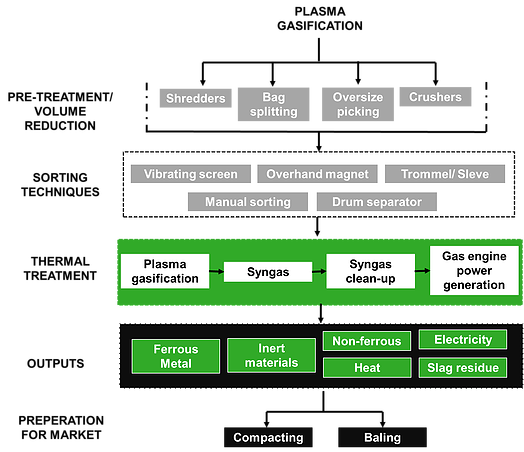Plasma gasification is a variation on gasification which uses a plasma torch/arch to produce gas. Plasma arc gasification is a waste treatment technology that uses high electrical energy and high temperature created by an electrical arc gasifier. This arc breaks down waste primarily into elemental gas and solid waste (slag), in a device called a plasma converter. The process is intended to be a net generator of electricity, depending upon composition input wastes, and to reduce the volumes of waste to being sent to landfill sites.

Configuration
Technology restrictions
- Requires expenditure for the purchase and operation of plasma torches/arc.
- Energy intensive and will drastically reduce the gross energy output of the facility.
Main license requirements for Plasma Gasification
Advantages:
- Potential to utilise higher efficiency energy recovery systems
- Production of clean slag which could be used as construction material
- Processing of organic waste into combustible syngas for electric power and thermal energy
Disadvantages:
- Requires highly skilled operators
- Requires specific feedstock
- Large initial investment costs
Aitkin County Plasma Gasification Study
Disposal of municipal solid waste, auto fluff, hazardous materials and medical wastes (potential feedstock for plasma gasification plants) have become increasingly expensive and challenging for communities. Aitkin County is considering options for a Plasma Energy Park, with a Plasma Gasification facility anchored by several complimentary businesses providing the aforementioned feedstock to curb the disposal concerns, along with creating jobs, helping the environment and other advantages. Plasma Gasification has been in use since the late 1800s in the metal industry, expanding into the chemical industry in the 1900s. The NASA Space program chose Plasma Gasification for simulating the extreme heat of reentry into earth’s atmosphere. Since then small prototype processes have been tested. Today, Plasma Gasification technology is again expanding to different feedstocks; with the first North American facility in Ottawa, Canada accepting municipal solid waste in 2007. Plasma torches heated up to 20,000°C and then gasify feedstock. The by-products include steam, electricity, syngas and rock wool. Very little is remaining of the feedstock once gasified. When considering the possibility of a facility, it is imperative to understand the merits and limitations. The information on the impacts – economic, environmental, and others - of operating a plant are uncertain and/or proprietary to the owners at this time. Existing pilot facilities in Japan and Spain own the rights to testing information, and are not required to publically announce results. Thus, public information is limited and regulatory agencies are working to accommodate pilot testing through careful monitoring.
